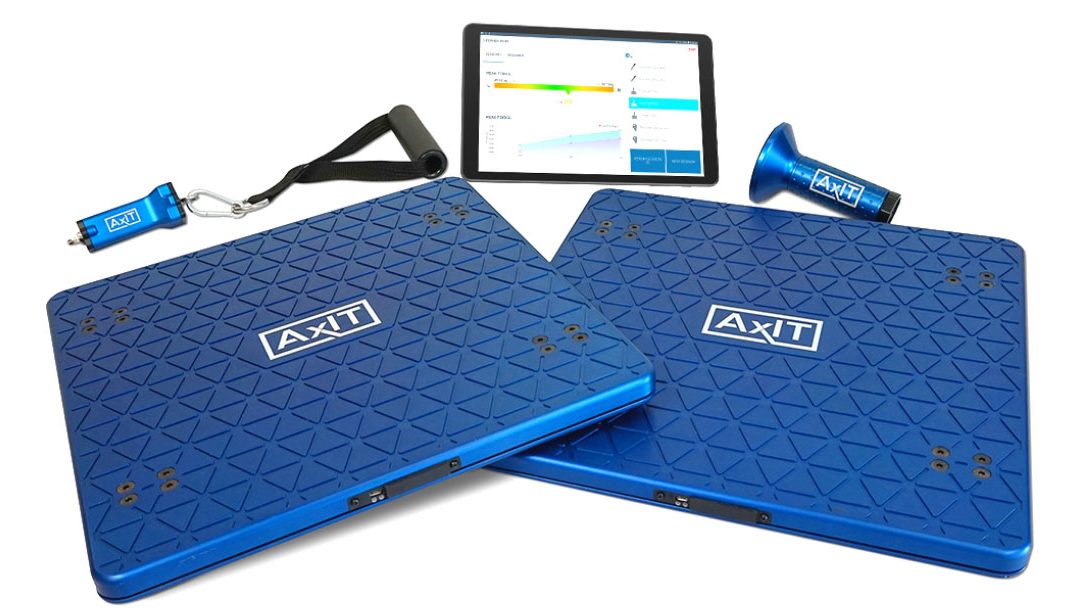The AxIT system is the world’s first complete objective movement assessment solution. We recently purchased this system to benefit the range of patients that we see in our clinic including everyday patients with musculoskeletal pain and injury, sports people, work cover clients, and those undertaking post-op rehabilitation.
The system uses force plates and dynamometers to assess strength, endurance and power of specific muscle groups. It assesses muscle force production patterns during functional movements and can analyse specific exercises. It consists of three devices that allows testing of multiple muscle groups and their specific movements – these devices are the Push-IT, Pull-IT, and Stomp-IT.
The Push-IT is a handheld dynamometer enabling us to accurately assess strength previously done using manual muscle testing. It allows us to quickly perform isolated strength assessments and record digital results. It can be used for upper and lower limb testing and can even be used to assess neck and back strength!
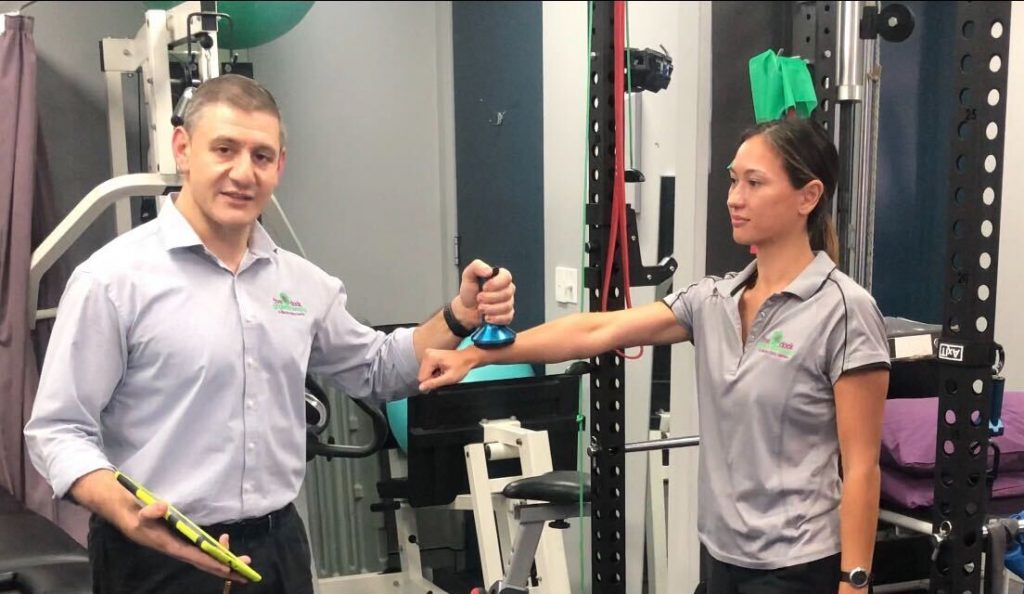
The Pull-IT is a small, extremely powerful device that allows us to assess and quantify dynamic movements giving real time feedback. It has a host of attachments allowing us to measure movements like thoracic rotation or lumbar extension strength, and other dynamic movements like shoulder internal rotation or leg extension through full range of motion.
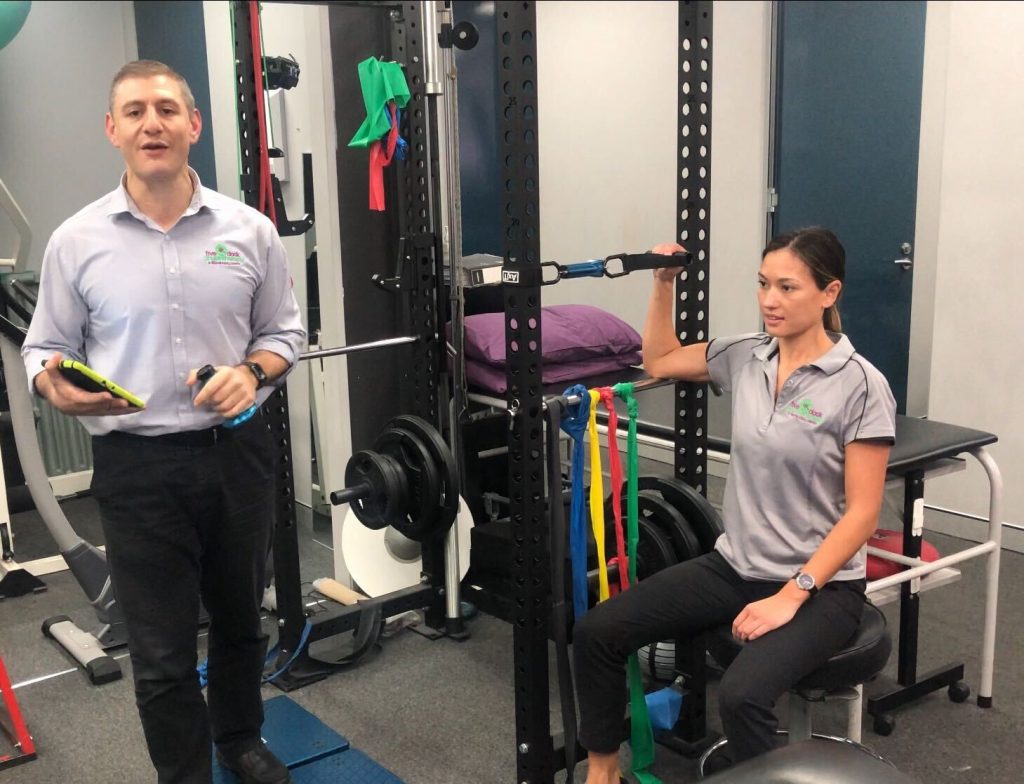
The Stomp-IT devices are 2 force plates that allow us to perform single and double limb assessments of both the lower and upper body. This includes analysis of squat, jump and landing mechanics both for single limb and double limb variations. We can assess activities like a push up and the force produced unilaterally, lifting capacity and even functional movements like lunging. This information was previously only available in elite sporting institutions and university biomechanics labs, but with the AxIT system in our clinic, we can now combine physical examination, science and technology to help our patients even more completely.
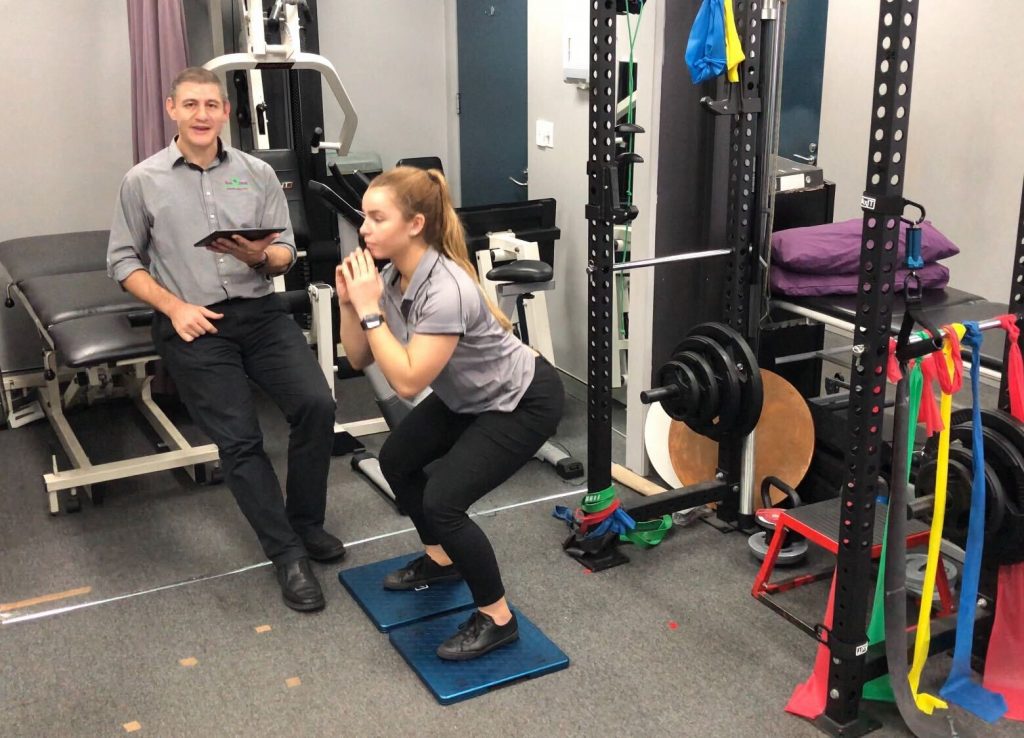
This data from the AxIT is collated in an online system and can be shown to the individual immediately after the assessment. It allows us to print reports for the patient and the ability to send reports back to referring doctors which is great for surgeons during post-op rehabilitation and can also demonstrate recovery of general injury to GP’s, and improved performance to personal trainers. This technology enhances our ability to not only settle down a patient’s symptoms but enables us to correct their deficits and also analyse the underlying cause that lead them to pain, injury and dysfunction.
What can the AxIT tell us?
The AxIT provides a considerable amount of data related to muscle strength, rate of force production, and the quality of overall movement. It allows us to identify muscle imbalances side to side and recognise the muscle capacity to generate force, and therefore, tolerate higher functional loads.
The report produced by the AxIT, will display force curves that allow us to analyse the data and develop exercise and rehabilitation programs to address these strength and control deficits, improving poor biomechanics, helping to minimise the risk of further injury and also helping to improve performance in athletes.
What are biomechanics? Brukner & Khan describe biomechanics as the description, analysis, and assessment of human movement during functional activities. Put simply, biomechanics is analysing how well we use our muscles to produce movement. Poor biomechanics and increased load are two extremely common causes of injury. By using the AxIT, we can help address any issues found.
CASE STUDY: Hamstring Strength after ACL Surgery
Let’s look at post-operative ACL repair, using a hamstring graft. (Not sure what the ACL is? Have a read here)
Why in this population group, is targeting the hamstring an imperative aspect of rehabilitation to achieve a good outcome?
- Usually, the graft from the ACL is taken from the patient’s hamstring muscle and tendon on the operated leg, meaning it will be weak and painful. Often there is associated loss of movement, reduced flexibility and weakness which leads to compensation patterns. We need to gradually load the hamstring muscle to maximise scar tissue healing and build up muscle strength.
- Aside from bending the knee itself, the hamstring has another primary role to protect the ACL. Essentially it does this by preventing anterior translation of the tibia on the femur, complimenting the role of the ACL. Therefore, it is crucial in regaining stability of the knee joint.
So why is the AxIT useful in this population?
Although clinically we know that the hamstring will be weak, it’s amazing to have a numerical value quantifying this! This is both useful for the physiotherapist to guide rehabilitation, and the patient to recognise the clear deficit side to side, particularly as symptoms start to settle and function increases. From a physio perspective, we can monitor changes and ensure the patients strength is improving. It can also be a strong indication to clear patients for higher functioning tasks such as running, jumping and changing directions. In this instance we can use either the Push-it or Pull it device to assess hamstring contraction helping to direct treatment and exercise programming.
Take a look at the graphs below – this is a patient who had a right ACL reconstruction 2 years ago and didn’t fully complete rehabilitation but wanted to return to sport. Here is his day 1 hamstring strength at the initial physiotherapy appointment:
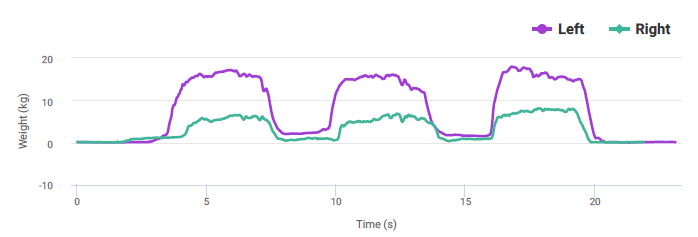

Here is his hamstring strength after working hard for 4 weeks:
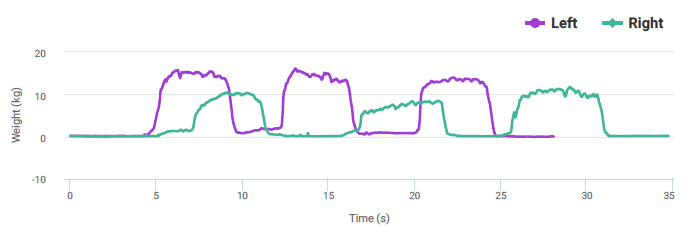

He has improved his right hamstring strength by 43% in 4 weeks! As you can see, his hamstring strength has improved significantly, however, there is still a 33% deficit compared to his left leg and a 5kg peak force deficit, so still some way to go.
In addition to showing side to side discrepancies, the AxIT can provide crucial information to assist us in exercise prescription. Take the curve below for example, showing good strength from side to side, however the control of the movement and ability to maintain force is poor – this shown by the jagged purple line at the top of each force curve compared to the smooth green force curve.
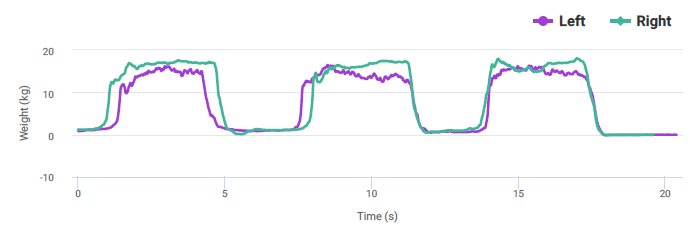
Similarly, the force curves can look the same but our ability to produce force quickly (i.e. produce power) may be limited. Below are some examples of this using the AxIT. The peak force has only an 18% discrepancy, but the rate of force development shows 56% discrepancy between left and right. This information can be critical, and before the AxIT we had no accurate or numerical way of measuring this.



Although strength is often a primary aim of rehabilitation, depending on the patient’s goals, it is important that dynamic and explosive movements are also retrained, and patients can demonstrate sufficient power. By being able to see this deficit in power output using the AxIT, we know that the patient is struggling with recruiting a large number of muscle fibres to develop force. This means we can be more specific with the exercise program in terms of the type of exercise, as well as the tempo or speed of the exercise, helping improve performance and reduce injury. Common explosive movements that require significant and equal power output side to side are running, sprinting, jumping, or any type of exercise that requires agility-type movements. We also need fantastic power output for throwing, serving, hitting type movements used in different sports. Without seeing this measure, patients may return to sport with discrepancies not only risking re-injury, but further, they risk injury to other components of the kinetic chain due to compensation strategies.
Another aspect of ACL recovery is squat, jump and landing analysis. Analysis of these movements are vital for running and a safe return to sport and activity in order to minimise the risk of a re-ruptured ACL. By using the AxIT, this time using the Stomp-IT device, we again are able to look at the force we generate to produce power and also accelerate and decelerate, and the AxIT device will tell us if there is a discrepancy from leg to leg. This helps patients objectively visualise their recovery and progress, and also allows our physio’s to programme adequate exercises to eliminate and improve specific deficits, reduce re-injury rates and improve performance.
Who can have an AxIT assessment?
The short answer is anyone can! The AxIT has over 120 tests and is able to analyse all areas of the body including specific testing protocols for each body part whether it be an arm, a leg or the spine.
In the clinic, the AxIT can be used as a part of an initial physiotherapy consultation to outline clear deficits in muscle strength, endurance, or power and we can do this by testing movements in isolation and also analysing functional movements. This can aid in diagnosis and provide good objective markers to show improvements throughout rehabilitation. In review consultations, the AxIT can help determine if a patient is ready to return to specific activities whether it be life tasks like lifting children, carrying boxes at work, returning to gym training, or returning to sport. It can also assist our physios in determining how much of a certain activity patients can return to in order to manage load, helping to reduce the chance of a recurrence in pain and/or injury.
Screening Assessments
Another application of the AxIT is for musculoskeletal screening assessments with our physiotherapists, which can be specifically designed to take strength measurements or assess functional movements relevant to a specific activity, occupational task, training routine such gym training, and includes specific sport screenings.
This can be useful to show improvements upon partaking in a new exercise program or can be used to design an exercise program targeting areas of weakness to improve performance and prevent injury. This can be perfect for someone that hasn’t exercised for a while letting them know where they are at but is also good for people that have had a previous injury. A good example of this is someone who has had a previous shoulder injury and wanted to return to sport (cricket, baseball, basketball, tennis) but lacks strength or does not feel confident in throwing/working above shoulder height. Using the AxIT we can help them design a specific program addressing their deficits. We can track and measure their improvements with training. Another example is in a patient with a previous knee or ankle injury noticing issues with running, jumping and changing direction but wanting to return to basketball, soccer, rugby, AFL or netball. An AxIT assessment can guide a safe return to activity.
AxIT screenings can also be used to help formulate appropriate areas to target during personal training sessions or gym work, and AxIT reports can be sent to patient’s personal trainers. Additionally, an AxIT Assessment can be used as a guide for people returning to work with lifting restrictions or as a screening for employers.
Would you like an Initial Physio Consultation using the AxIT OR an AxIT Screening?
Let the AxIT guide your recovery, help you prevent injury and improve your performance:

- Know your numbers
- Recover faster from pain or Injury
- Get accurate strength testing
- Measure muscle imbalances
- Accurately know when you are ready to return to activity and sport

